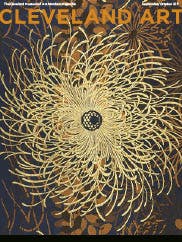Cleveland Art, September/October 2017
Tags for: Cleveland Art, September/October 2017
- Member Magazine
Published: August 24, 2017
In this issue of the members magazine: The Jazz Age; Rodin–100 Years; Gods and Heroes; Fashionable Mourners; This Fall at Transformer Station; ArtLens Gallery at a Glance; Emily J. Peters; Talks, Classes, and Experiences.
The Jazz Age
The decade of the twenties was a glorious age for art and design. As Europe emerged from the smoke and devastation of the First World War, American patronage and culture helped transform the marketplace at home and abroad. Talent and craftsmanship, urbanity and experimentation flowed back and forth...
Rodin—100 Years
Widely regarded as the founder of modern sculpture, Auguste Rodin (1840–1917) remains one of the most consequential figures in the history of art. Inspired by great artists of the past, especially Michelangelo, he viewed the human form as the ideal vehicle for conveying inner emotion and complex sym...

The initial installation of the east wing glass box in 2008 featured Rodin sculptures, including The Age of Bronze. The exhibition Rodin—100 Years again takes advantage of this beautiful view.
Gods and Heroes
In the history of European civilization, the term Renaissance describes a surge of interest in ancient Greek and Roman knowledge, literature, and art that occurred around 1400 to 1600. The Renaissance originated in Italy when scholars began reading and translating long-forgotten classical texts. Th...

Venus Wounded by a Rose’s Thorn (Left) c. 1516. Marco Dente (Italian, c. 1486–1527), after Raphael (Italian, 1483–1520). Engraving; sheet: 26.1 x 16.8 cm. Dudley P. Allen Fund, 1930.581
Adam and Eve (Right) 1504. Albrecht Dürer (German, 1471–1528). Engraving; sheet: 25.2 x 19.4 cm. Dudley P. Allen Fund, 1944.473
Fashionable Mourners
Cleveland’s four celebrated early 15th-century alabaster tomb mourners are part of a major exhibition this fall at the renowned Rijksmuseum in Amsterdam. In exchange, the CMA will exhibit four bronze mourners—traveling to North America for the first time––from the tomb of Isabella of Bourbon (1436–1...

Mourners from the Tomb of Isabella of Bourbon, c. 1475–76. Attributed to Jan Borman the Younger (Netherlandish, active 1479–1520); casting attributed to Renier van Thienen (Flemish, active 1460–1541). Brass copper alloy; avg. h. 56 cm. On loan from the City of Amsterdam, BK-AM-33-B, I, D, F
This Fall at Transformer Station
Debris, leftovers, the aftermath of other efforts, materials only partially identifiable—like the scene after an accident or disaster, only too clean for that, too controlled. And not the kind of unidentifiable that happens in real life after the car crash or flood, not the kind with real loved ones...

Emily J. Peters
Last spring Emily J. Peters joined the museum after a dozen years at the Museum of Art, Rhode Island School of Design, in Providence. She holds an MA and a PhD in art history from the University of California, Santa Barbara, and a BA from the University of Michigan. Here she shares thoughts about th...

Emily J. Peters, Curator of Prints and Drawings
